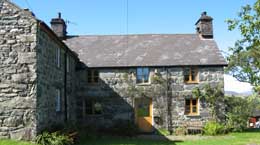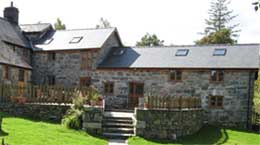About
History
Maesgwm is situated around eight hundred feet above sea level. The earliest foundation for the farm buildings was laid circa 1805 and the land stretched as far as the Gamlan river and included this side of the Rhiniogs. In 1922 the Forestry Commission purchased the land and its properties to develop the house and their employees. Family members of the current owner came to live here in 1932. When they moved in there was no electricity or water, so the cooking was done on an old black leaded grate.
The land supported cows, hens, sheep and pigs. Shire horses were kept in the stable for work in the forestry during the week and on the land at the weekends. In latter years, the land around the smallholding has not been used and become a haven for wildlife. Today we have a small amount of both sheep and pigs but are nowhere near as self sufficient as our predecessors.
The site was a working farm until early last century when the Forestry Commission bought it and all it its surrounding land. It had a mountain and land stretching as far as the Gamlan river and all was in the parish of Llanddwyweuwchygraig. Ganllwyd village has 5 parishes. The farmsteads and immediate land were rented out to the Forest workers at a reduced rate and their income was subsidised by managing the small holdings. They would have a cross section of animals and crop – some cows, sheep hens and each had a pig. At Maesgwm, Will had two shire horses, which he subcontracted to the forestry. They pulled trees onto the roads all day long but Sam the horse would not work after 4.30pm.
Hay would be harvested to feed the animals in winter. They had no electricity and each house had at least two wells to supply water. Will kept a spade and a gun by the back door. In the winter of ‘47/48 the snow fell each day and froze each night to the degree that Will had to tunnel his way through from the back door of the farmhouse to the now main kitchen door of the barn to feed the cows. Jane got water by opening a bedroom window and scooping snow into a saucepan. There was always live yeast in the pantry, plenty of flour and often an old boiler would find itself in a pot so they did not go hungry. There was an Italian prisoner of war camp just down the road and Ken (who only spoke Welsh at home) leant both English and Italian on his visits there. He would swoop under the gates and sit with the men for hours. Security was non-existent, the men roaming into Dolgellau at will and of course non escaped – life was good at The Camp. At Bronaber, also known as Tintown, there was a large army camp and they practised on the Ranges. On fair days and Saturdays extra buses would be provided to accommodate all passengers to and from Dolgellau. Life was busy.
Will and Jane came to live at Maesgwm in 1934 and soon got used to the residents – a colony of pipistrelle bats that are still here today.


